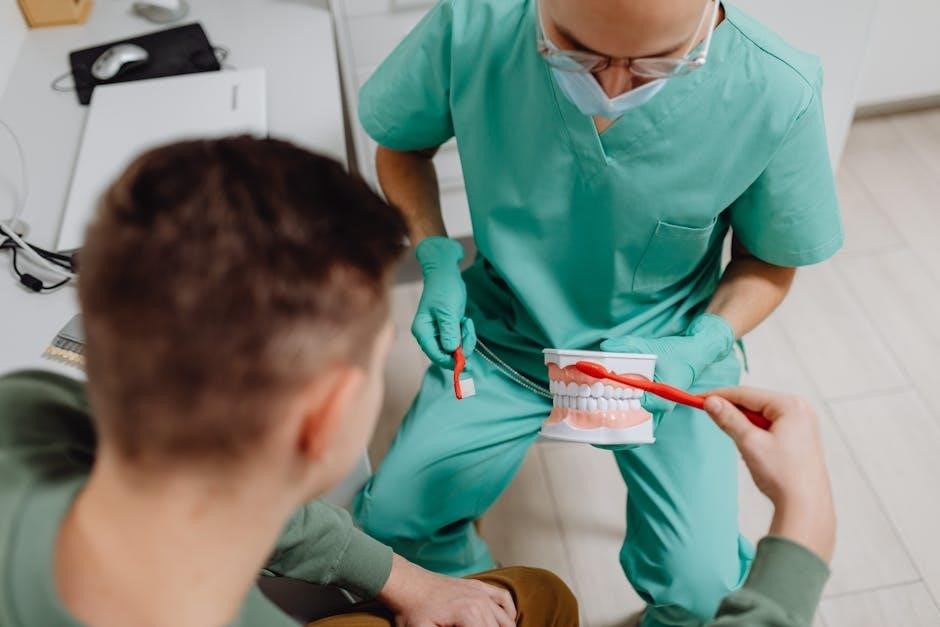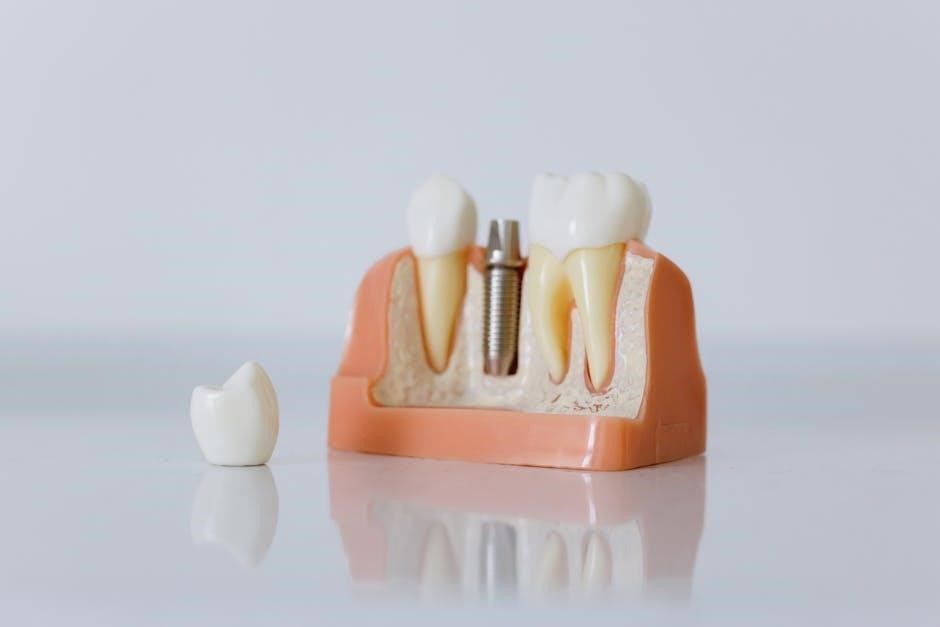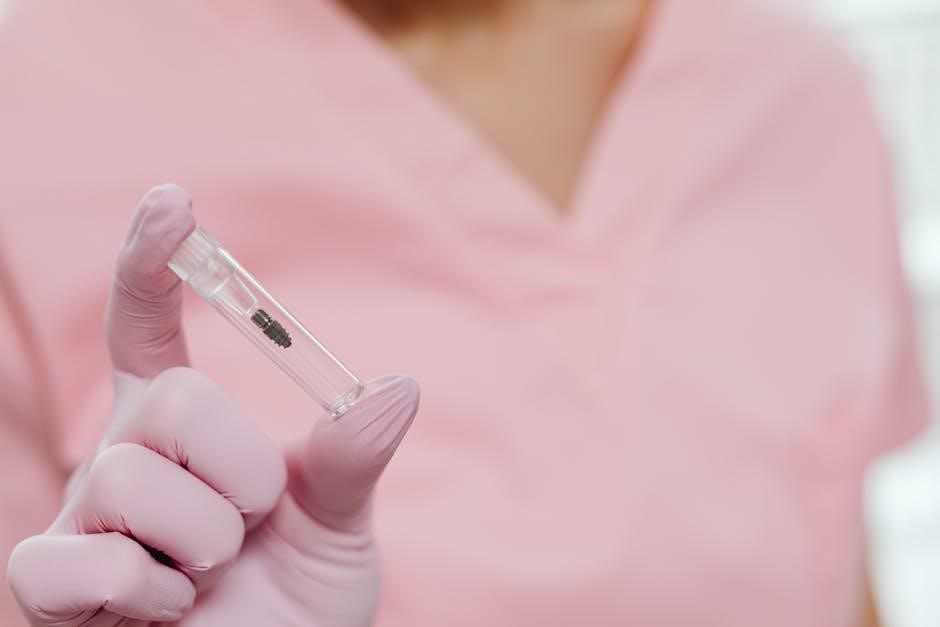Immediate Post-Operative Care for Dental Implant Patients
After dental implant surgery, avoid vigorous rinsing, using straws, smoking, spitting, or disturbing the implant site for 48 hours to protect the blood clot and ensure proper healing.
1.1 Activities to Avoid in the First 48 Hours
Immediately after dental implant surgery, certain activities must be avoided to ensure proper healing. Refrain from vigorous rinsing, using straws, smoking, spitting, or disturbing the implant site for at least 48 hours. Avoid eating hard, crunchy, or chewy foods, as these can dislodge the blood clot or damage the implant. Do not spit or suck on anything, as this can create negative pressure and disrupt healing. Limit talking and avoid strenuous activities to minimize swelling and discomfort. Adhering to these restrictions helps protect the blood clot and supports the initial stages of osseointegration.
1.2 Managing Bleeding After Implant Placement
Some bleeding after dental implant placement is normal and may last several hours. To manage it, apply gentle pressure with gauze for 10-15 minutes. Use cool packs on the cheeks, jaws, or chin to reduce swelling. Avoid spitting, rinsing vigorously, or disturbing the implant site, as this can dislodge the blood clot. If bleeding increases or persists, contact your dentist. Keep your head elevated to minimize blood flow to the area; Follow these steps to promote clotting and support the healing process.

Pain Management and Discomfort Relief
Use prescribed pain medications or over-the-counter options like ibuprofen as directed. Rest and avoid strenuous activities to reduce discomfort. Stay hydrated and follow post-op guidelines carefully.
2.1 Recommended Pain Relief Medications
For post-implant discomfort, over-the-counter pain relievers like ibuprofen (e.g., Advil) or acetaminophen (e.g., Tylenol) are effective. Ibuprofen reduces inflammation, while acetaminophen helps with pain.
Naproxen is another option for prolonged relief. Always follow recommended dosages and consult your dentist for stronger prescriptions if needed.
Avoid exceeding the maximum daily dose to prevent side effects.
If pain persists or worsens, contact your dentist to rule out complications.
2.2 What to Avoid When Managing Pain
When managing pain after dental implant surgery, avoid smoking and alcohol, as they can delay healing and increase discomfort.
Do not exceed recommended dosages of pain relief medications to minimize side effects.
Refrain from taking NSAIDs without consulting your dentist, as they may interfere with clotting.
Avoid chewing on the implant site or eating hard, crunchy foods until healed.
If pain increases or persists beyond expected levels, contact your dentist promptly to address potential complications.

Dietary Guidelines After Dental Implant Surgery
Eat soft, mild, and nutritionally balanced foods to support healing. Avoid carbonated drinks, hard, crunchy, or chewy foods for 8 weeks. Stick to a gentle diet.
3.1 Soft Foods Recommended for the Healing Period
During the healing period, opt for soft, nutrient-rich foods like soups, scrambled eggs, yogurt, mashed vegetables, and soft-cooked pasta. These foods are gentle on the implant site and promote healing. Avoid chewing directly over the implant. Include proteins such as soft fish or tofu and consider adding smoothies or pureed fruits for essential vitamins. Dairy products like cheese and milk are also beneficial. Ensure meals are balanced to support recovery. Avoid hard, crunchy, or chewy foods for at least 8 weeks. Stick to a gentle diet to minimize discomfort and protect the implant.
3.2 Foods and Drinks to Avoid During Recovery
Avoid hard, crunchy, or chewy foods like nuts, chips, and hard candies, as they can damage the implant site. Carbonated beverages and sugary drinks should also be avoided due to their acidic nature. Skip spicy or overly hot foods that may irritate the healing area. Refrain from consuming anything that requires heavy chewing or biting forces on the implant. Additionally, avoid alcohol and caffeine, as they can interfere with healing and increase bleeding risk. Stick to a soft, gentle diet for at least 8 weeks to ensure proper healing and implant integration.

Oral Hygiene Practices Post-Implant Surgery
Practice gentle cleaning with a soft toothbrush and mild toothpaste. Avoid harsh brushing or flossing near the implant site. Use saline solution for rinsing to promote healing.
4.1 Gentle Cleaning Techniques for the Implant Site
Use a soft toothbrush and mild toothpaste to gently clean the implant site. Avoid harsh or abrasive products. Rinse with saline solution to promote healing. Do not floss or use interdental brushes near the implant. Instead, clean around the area with a gentle circular motion. Avoid using mouthwash containing alcohol or harsh chemicals. Begin cleaning the day after surgery, but avoid direct pressure on the implant. Use a clean, damp cloth to wipe the area if needed. Proper cleaning prevents infection and supports healing. Follow your dentist’s specific instructions for maintaining hygiene during recovery.
4.2 Avoiding Certain Oral Hygiene Practices
Avoid vigorous rinsing, using straws, or smoking for 48 hours post-surgery. Do not floss or use interdental brushes near the implant site. Refrain from using harsh mouthwashes or abrasive toothpaste. Avoid spitting or sucking on anything, as this can dislodge the blood clot. Do not use alcohol-based mouthwashes, as they can slow healing. Avoid brushing directly over the implant site during the initial healing phase. Steering clear of these practices reduces the risk of complications and promotes a smooth recovery. Always follow your dentist’s specific oral hygiene instructions to ensure proper healing.

Lifestyle Habits to Avoid During Healing
Smoking significantly impairs healing, while excessive alcohol consumption and stress can hinder recovery. Avoid these habits to promote proper bone integration and optimal healing of the implant.
5.1 The Impact of Smoking on Implant Healing
Smoking significantly hinders the healing process after dental implant surgery by reducing blood flow to the gums and introducing toxins that impair osseointegration. This increases the risk of complications, including implant failure. Smoking delays tissue repair and can lead to infections or prolonged recovery times. Even temporary cessation during the healing period is insufficient, as the negative effects of smoking persist. Complete avoidance of smoking is crucial for optimal implant integration and long-term success. Patients are encouraged to consult their dentist for resources to aid in quitting smoking before and after implant placement.
5.2 Other Lifestyle Factors to Consider
Beyond smoking, other lifestyle factors can influence implant healing. Heavy lifting, bending, or strenuous exercise should be avoided in the initial recovery period, as these activities may disrupt the surgical site. Excessive alcohol consumption can also impair healing and should be minimized. Additionally, maintaining good overall health, including a balanced diet, is essential for proper tissue repair. Patients should adhere to their dentist’s instructions regarding oral hygiene and avoid habits that may irritate the implant site. Neglecting these recommendations can lead to complications, such as delayed healing or implant failure, underscoring the importance of careful lifestyle choices during recovery.

Monitoring Healing Progress
Monitor for swelling, bruising, and mild discomfort, which are normal and typically resolve within two weeks. Track healing progress to ensure proper recovery and address concerns promptly.
6.1 Signs of Normal Healing
Normal healing includes swelling, bruising, and mild discomfort, typically resolving within two weeks. Light bleeding may occur, forming a clot that protects the implant site. Gentle oozing and the presence of a blood clot are natural signs of healing. The surgical site may appear red or tender but should gradually improve. Monitor for these signs to ensure proper recovery. If unusual symptoms persist, contact your dentist promptly to address any concerns.
6.2 When to Contact Your Dentist
Contact your dentist immediately if you experience excessive bleeding, severe pain, or swelling that worsens over time. Signs of infection, such as redness, pus, or a foul odor, require prompt attention. If the implant feels loose or shifts, notify your dentist. Numbness or tingling in the lips, tongue, or face should also be reported. Additionally, reach out if you notice unusual healing delays or persistent discomfort beyond the expected recovery period. Early intervention ensures complications are addressed before they affect the implant’s success.

Follow-Up Care and Appointments
Regular follow-up appointments are crucial for monitoring healing progress and ensuring proper implant integration. Attend all scheduled visits to allow your dentist to assess recovery and make adjustments.
7.1 Importance of Scheduled Follow-Up Visits
Scheduled follow-up visits are essential for ensuring proper healing and implant integration. These appointments allow your dentist to monitor the progress of your recovery, check for any potential complications, and make necessary adjustments. Regular check-ups help confirm that the implant is healing as expected and that the surrounding bone and tissue are adapting well. Timely interventions can address minor issues before they become significant problems. Consistent follow-up care is critical for achieving optimal results and ensuring the long-term success and stability of your dental implants.
7.2 What to Expect During Follow-Up Appointments
‘. They provided some instructions that I need to follow carefully.
First, I need to make sure I don’t include any information that’s covered in other subheadings. That means I should focus solely on what happens during these follow-up appointments without touching on their importance or other aspects of care.
Looking at the information provided from the internet, I see mentions of monitoring healing progress, checking implant integration, and ensuring proper recovery. I should incorporate these points. Maybe also include specific activities like examining the surgical site, assessing the implant’s stability, reviewing the patient’s adherence to post-op instructions, and providing feedback on oral hygiene.
I should also consider the structure. Starting with a general statement about the purpose of the appointments, then listing what the dentist does, and maybe emphasizing the role of the patient in these follow-ups.
Let me draft this out:
During follow-up appointments, your dentist will monitor healing progress, check implant integration, and ensure proper recovery. They will examine the surgical site, assess implant stability, and review your adherence to post-op instructions. This is also a time to address any concerns or questions you have. Regular check-ups help ensure the implant is healing as expected, and any necessary adjustments can be made. These visits are crucial for confirming that the implant is functioning well and that the surrounding tissue is adapting properly.
Now, I need to count the words to make sure it’s exactly 94. Let me check:
During
follow-up
appointments,
your
dentist
will
monitor
healing
progress,
check
implant
integration,
and
ensure
proper
recovery.
They
will
examine
the
surgical
site,
assess
implant
stability,
and
review
your
adherence
to
post-op
instructions.
This
is
also
a
time
to
address
any
concerns
or
questions
you
have.
Regular
check-ups
help
ensure
the
implant
is
healing
as
expected,
and
any
necessary
adjustments
can
be
made.
These
visits
are
crucial
for
confirming
that
the
implant
is
functioning
well
and
that
the
surrounding
tissue
is
adapting
properly.
Hmm, that’s . I need to add 12 more without overlapping with other sections. Maybe add something about personalized feedback or future steps.
Let me adjust:
During follow-up appointments, your dentist will monitor healing progress, check implant integration, and ensure proper recovery. They will examine the surgical site, assess implant stability, and review your adherence to post-op instructions. This is also a time to address any concerns or questions you have. Regular check-ups help ensure the implant is healing as expected, and any necessary adjustments can be made; These visits are crucial for confirming that the implant is functioning well and that the surrounding tissue is adapting properly; Your dentist may also provide personalized feedback on oral hygiene and outline the next steps in your care.
Now, let’s count again:
During
follow-up
appointments,
your
dentist
will
monitor
healing
progress,
check
implant
integration,
and
ensure
proper
recovery.
They
will
examine
the
surgical
site,
assess
implant
stability,
and
review
your
adherence
to
post-op
instructions.
This
is
also
a
time
to
address
any
concerns
or
questions
you
have.
Regular
check-ups
help
ensure
the
implant
is
healing
as
expected,
and
any
necessary
adjustments
can
be
made.
These
visits
are
crucial
for
confirming
that
the
implant
is
functioning
well
and
that
the
surrounding
tissue
is
adapting
properly.
Your
dentist
may
also
provide
personalized
feedback
on
oral
hygiene
and
outline
the
next
steps
in
your
100. care.
Oops, that’s . I need to trim it down. Maybe remove the last part about next steps.
Final version:
During follow-up appointments, your dentist will monitor healing progress, check implant integration, and ensure proper recovery. They will examine the surgical site, assess implant stability, and review your adherence to post-op instructions. This is also a time to address any concerns or questions you have; Regular check-ups help ensure the implant is healing as expected, and any necessary adjustments can be made. These visits are crucial for confirming that the implant is functioning well and that the surrounding tissue is adapting properly. Your dentist may provide personalized feedback on oral hygiene.
Counting again:
During
follow-up
appointments,
your
dentist
will
monitor
healing
progress,
check
implant
integration,
and
ensure
proper
recovery.
They
will
examine
the
surgical
site,
assess
implant
stability,
and
review
your
adherence
to
post-op
instructions.
This
is
also
a
time
to
address
any
concerns
or
questions
you
have.
Regular
check-ups
help
ensure
the
implant
is
healing
as
expected,
and
any
necessary
adjustments
can
be
made.
These
visits
are
crucial
for
confirming
that
the
implant
is
functioning
well
and
that
the
surrounding
tissue
is
adapting
properly.
Your
dentist
may
provide
personalized
feedback
on
oral
hygiene.
That’s . I need to add three more. Maybe include something about scheduling future appointments.
Final tweak:
During follow-up appointments, your dentist will monitor healing progress, check implant integration, and ensure proper recovery. They will examine the surgical site, assess implant stability, and review your adherence to post-op instructions. This is also a time to address any concerns or questions you have. Regular check-ups help ensure the implant is healing as expected, and any necessary adjustments can be made. These visits are crucial for confirming that the implant is functioning well and that the surrounding tissue is adapting properly; Your dentist may provide personalized feedback on oral hygiene and schedule any needed future appointments.
Now, counting:
During
follow-up
appointments,
your
dentist
will
monitor
healing
progress,
check
implant
integration,
and
ensure
proper
recovery.
They
will
examine
the
surgical
site,
assess
implant
stability,
and
review
your
adherence
to
post-op
instructions.
33
8.2 Avoiding Long-Term Damaging Habits
Long-Term Care for Dental Implants
For long-term dental implant care, maintain good oral hygiene, avoid hard or crunchy foods, and attend regular dental check-ups to ensure implant longevity and overall health.
